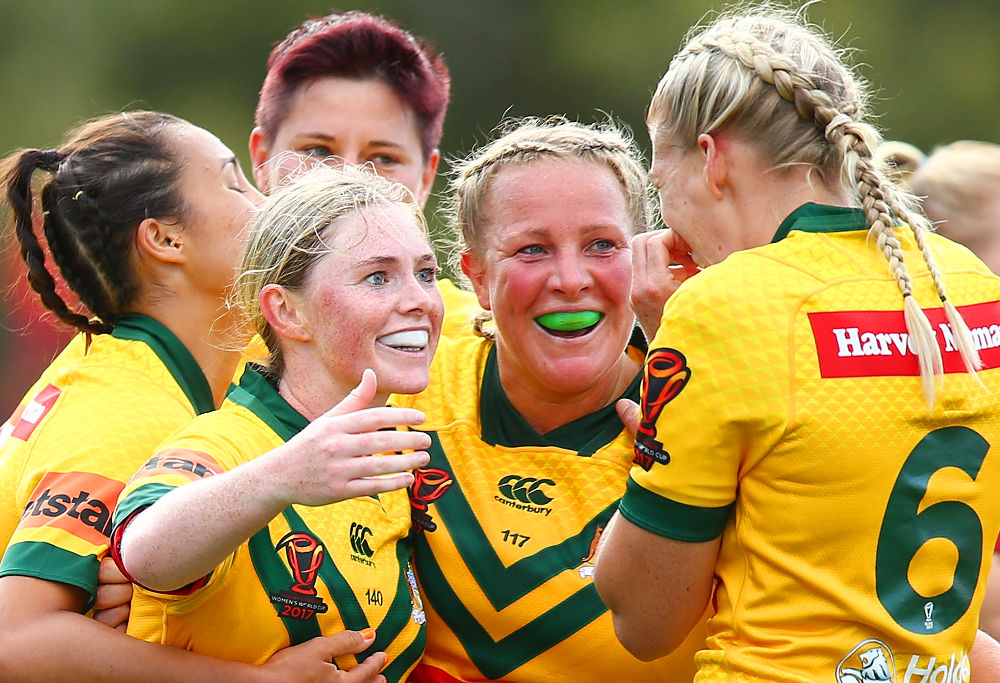On December 6, 2017, the National Rugby League changed forever – and for the better – with a historic announcement regarding changes to the elite women’s program.
Led by Yvonne Sampson, the announcement was made by John Grant and Todd Greenberg, while Ruan Sims and Corban McGregor were also present.
Let’s begin with the most exciting part of the announcement: next year will see the launch of the NRL Women’s Premiership, to be played in the lead up to and during the NRL finals.
It is extremely difficult for me to put into words how much this means to me – I cried listening to Greenberg speak.
I cried for women like Karyn Murphy, Kasey Badger and Katrina Fanning, who never got their opportunity to play professional rugby league.
I cried for women like Ruan Sims, who has waited her entire career for this opportunity.
But most of all, I cried for the next generation, who I don’t know yet, but who will get their opportunity going forward.
This competition – following the lead of other major sports in this country like cricket and AFL – will see the women’s game properly resourced, readily accessible, and appropriately promoted.
It will also ensure that young women who are dreaming about a career in professional rugby league can live their reality.
It’s unclear which teams will compete, but Greenberg indicated that NRL clubs would all have the opportunity to put in bids and that, at this stage, it would be a six-team comp.
Almost every club in the NRL appears interested, but some in particular have signalled their intention to be leaders in the women’s game.
The Cronulla Sharks were the first club to offer contracts to female players (Ruan Sims in 2016), clubs like the St George Illawarra Dragons already have Jillaroos like Kezie Apps involved as ambassadors, and Newcastle has a very strong local competition, featuring players like Caitlin Moran, Rebecca Young and Isabelle Kelly.
If at least one club from Queensland is included and a team is included from New Zealand, it leaves little space for further representation from New South Wales.
I’m looking forward to additional details on the bid process and how talent will be evenly distributed.
But this is not the only change to celebrate.
The Interstate Challenge is no longer and will be replaced with a State of Origin match between New South Wales and Queensland to be played on the stand-alone representative weekend.
The Jillaroos will also have additional opportunities to play representative football, with Test matches in the Pacific and New Zealand. Not only is this positive for Australian women, it also allows countries like New Zealand and Papua New Guinea (fan favourites at the Women’s Rugby League World Cup) to participate too.
The NRL also announced that next year we will have 40 contracted Jillaroos players.
This is a fitting reward for the women who represented Australia so passionately and were crowned champions at the World Cup on the weekend, following their 23-16 win over the Kiwi Ferns.
Giving these women the opportunity to take their game to the next level by making them professional will ensure that the elite program continues to be recognised as the best in the world.
To break this down, this means that from 2018, the female pathway will be well established. Women will have the opportunity to play grassroots junior league, then move into state competitions, then premiership matches, and potentially representative honours through State of Origin and the Jillaroos.
In the next few years we will see women coming through who have played from age six, all the way through to the NRL. I can’t wait for this day.

To every woman who has played rugby league – thank you. We made it.
To the media, advocates and fans who have celebrated, reported on and promoted the women’s game – thank you for continuing to push for this to happen and for your ongoing support.
To Harvey Norman and in particular, Katie Page and Steph Crockford, who have been the most staunch of supporters for women in sport, but particularly for women in rugby league – thank you for your continued commitment.
I also want to thank the NRL for their leadership and commitment.
The women’s game is the fastest growing participation space in rugby league, having grown 32 per cent in the last year alone. Wednesday’s announcement will see this participation figure skyrocket in the years to come.
[latest_videos_strip category=”rugby-league” name=”League”]
But what about us as fans? So many have been demanding a women’s competition – now we’ve got it and we have a responsibility too.
We have a responsibility to celebrate the clubs and women competing. We have a responsibility to get our bums onto seats next year and to watch these women play. But most of all, we have a responsibility to make sure that the NRL recognises how much interest there is in this competition and understand their important obligation to make this a sustainable, exciting product.
With women like Ruan Sims, Kezie Apps, Maddie Studdon and Talesha Quinn involved, I have no doubt that it will be a tremendous success.
On Wednesday, the NRL sent a powerful message of diversity and inclusion. It said to all the women and girls out there that there is a place for them in the rugby league family, and that they can aspire to play professional rugby league.
The future has arrived and I’m ready to embrace it with open arms.
In 2017 history was announced. In 2018 we will watch history happen.






























































































